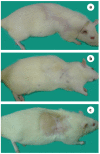Radical Tumor Denervation Activates Potent Local and Global Cancer Treatment
- PMID: 37568574
- PMCID: PMC10417359
- DOI: 10.3390/cancers15153758
Radical Tumor Denervation Activates Potent Local and Global Cancer Treatment
Abstract
This preliminary study seeks to determine the effect of R&P denervation on tumor growth and survival in immunocompetent rats bearing an aggressive and metastatic breast solid tumor. A novel microsurgical approach was applied "in situ", aiming to induce R&P denervation through the division of every single nerve fiber connecting the host with the primary tumor via its complete detachment and re-attachment, by resecting and reconnecting its supplying artery and vein (anastomosis). This preparation, known as microsurgical graft or flap, is radically denervated by definition, but also effectively delays or even impedes the return of innervation for a significant period of time, thus creating a critical and therapeutic time window. Mammary adenocarcinoma cells (HH-16.cl4) were injected into immunocompetent Sprague Dawley adult rats. When the tumors reached a certain volume, the subjects entered the study. The primary tumor, including a substantial amount of peritumoral tissue, was surgically isolated on a dominant artery and vein, which was resected and reconnected using a surgical microscope (orthotopic tumor auto-transplantation). Intending to simulate metastasis, two or three tumors were simultaneously implanted and only one was treated, using the surgical technique described herein. Primary tumor regression was observed in all of the microsurgically treated subjects, associated with a potent systemic anticancer effect and prolonged survival. In stark contrast, the subjects received a close to identical surgical operation; however, with the intact neurovascular connection, they did not achieve the therapeutic result. Animals bearing multiple tumors and receiving the same treatment in only one tumor exhibited regression in both the "primary" and remote- untreated tumors at a clinically significant percentage, with regression occurring in more than half of the treated subjects. A novel therapeutic approach is presented, which induces the permanent regression of primary and, notably, remote tumors, as well as, evidently, the naturally occurring metastatic lesions, at a high rate. This strategy is aligned with the impetus that comes from the current translational research data, focusing on the abrogation of the neuro-tumoral interaction as an alternative treatment strategy. More data regarding the clinical significance of this are expected to come up from a pilot clinical trial that is ongoing.
Keywords: abscopal effect; cancer neurobiology; microsurgery; radical denervation; tumor denervation; tumor regression.
Conflict of interest statement
There are no financial conflict of interest to disclose.
Figures












Similar articles
-
Denervation leads to volume regression in breast cancer.J Plast Reconstr Aesthet Surg. 2018 Jun;71(6):833-839. doi: 10.1016/j.bjps.2018.03.012. Epub 2018 Mar 28. J Plast Reconstr Aesthet Surg. 2018. PMID: 29653898
-
Robotic total thyroidectomy with modified radical neck dissection via unilateral retroauricular approach.Ann Surg Oncol. 2014 Nov;21(12):3872-5. doi: 10.1245/s10434-014-3896-y. Epub 2014 Sep 17. Ann Surg Oncol. 2014. PMID: 25227305
-
Overview of resistance to systemic therapy in patients with breast cancer.Adv Exp Med Biol. 2007;608:1-22. doi: 10.1007/978-0-387-74039-3_1. Adv Exp Med Biol. 2007. PMID: 17993229 Review.
-
No need to cut the nerve in LD reconstruction to avoid jumping of the breast: a prospective randomized study.J Plast Reconstr Aesthet Surg. 2014 Aug;67(8):1106-10. doi: 10.1016/j.bjps.2014.04.029. Epub 2014 May 13. J Plast Reconstr Aesthet Surg. 2014. PMID: 24933238 Clinical Trial.
-
Microsurgical Denervation of the Spermatic Cord: A Historical Perspective and Recent Developments.Sex Med Rev. 2022 Oct;10(4):791-799. doi: 10.1016/j.sxmr.2021.11.005. Epub 2022 Jan 5. Sex Med Rev. 2022. PMID: 34996747 Review.
Cited by
-
Social Genomic Determinants of Health: Understanding the Molecular Pathways by Which Neighborhood Disadvantage Affects Cancer Outcomes.J Clin Oncol. 2024 Oct 20;42(30):3618-3627. doi: 10.1200/JCO.23.02780. Epub 2024 Aug 23. J Clin Oncol. 2024. PMID: 39178356 Review.
-
The Crosstalk between Nerves and Cancer-A Poorly Understood Phenomenon and New Possibilities.Cancers (Basel). 2024 May 15;16(10):1875. doi: 10.3390/cancers16101875. Cancers (Basel). 2024. PMID: 38791953 Free PMC article. Review.
References
-
- Patterson J.T., Olson J.S. The History of Cancer: An Annotated Bibliography. J. Am. Hist. 1991;77:1475. doi: 10.2307/2078448. - DOI
LinkOut - more resources
Full Text Sources

